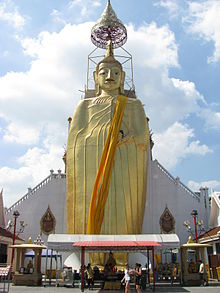Wat Intharawihan
Wat Intharawihan ( Thai : วัด อินทรวิหาร , other spellings: Wat Indrawihan, Wat Indraviharn, Wat Intharavihara) is a Buddhist temple ( Wat ) in Bangkok , the capital of Thailand . It is a Third Class Royal Temple .
location
Wat Intharawihan is located in the northern part of the Phra Nakhon district on the now heavily trafficked Thanon Wisut Kasat (Wisut Kasat Road) , the eastern driveway to the Rama VIII Bridge .
history
Wat Intharawihan was built as early as the late Ayutthaya period . It was initially called Wat Rai Phrik ( วัดไร่ พริก, "Temple on the Chilli Plantation"), because it was in the middle of vegetable gardens. During the early Rattanakosin period, King Rama I had Laotian prisoners of war from the Kingdom of Vientiane settled in this district (Bang Khun Phrom) . Chao Inthawong ( เจ้า อิน ท วงศ์ ), a son of the Laotian king Bunsan, was among the resettlers . He had the temple restored, which was then renamed Wat Intharam in honor of its sponsor .
In the 19th century, Somdet Phra Phutthachan (To) , one of the most revered monks in Thai history, initiated the construction of the gigantic standing Buddha statue. However, this was not completed until March 1928. Somdet To had already died in Wat Intharawihan in 1872, which is why this temple is also a special place of worship for this prominent Buddhist teacher. The temple got its current name at the behest of King Rama VI. (Vajiravudh) to be able to distinguish it from Wat Intharam of the same name in Thonburi .
Surname
The name is composed of Wat (Thai for temple or monastery), Indra (name of a deity from India) and Wihan (assembly hall of the monks in Buddhist monasteries, from Sanskrit vihara "refuge"). A popular short name is Wat In ( วัด อินทร์ ), which means "Temple of Indra". Also popular is the name Wat Luang Pho To , derived from the large Buddha statue for which the temple is mainly known.
Attractions
- Luang Pho Tho ( หลวง พ่อ โต, พระ ศรี อริย เมตไตรย ) - 32 meter high Buddha statue in the center of the temple. The Buddha is shown standing here, his hand position ( mudra ) is described in the "List of 40 Buddha Statues" from the time of King Nang Klao (Rama III) under number 20 as holding the alms bowl . The statue is called "Luang Pho Tho", it is covered with mosaic stones made of colored glass and 24-carat gold. His ushnisha contains a relic of the Buddha that was donated to the Thai government by the Sri Lankan government . The then Crown Prince Maha Vajiralongkorn locked the relic in the statue in 1978.
- Ubosot ( พระ อุโบสถ ) - Ordination hall in the style of the late Ayutthaya period, its base has been clad with Italian marble since the renovation in 1982, inside there are modern wall paintings in traditional style.
- “The holy spring of Phra Putthachan” ( บ่อน้ำ พระพุทธ มนต์ สมเด็จ พระ พุ ฒา จาร ย์ (โต พรหม รํ สี) ) - the wax figure of the revered abbot is located in a small octagonal new building above a bubbling spring of holy water. The semi-dark room, cooled by air conditioning, is covered on the walls with shelves containing vials of holy water from different parts of Thailand. Because of the unique atmosphere, this small building is often used by locals for meditation.
- Guanyin Shrine ( วิหาร พระ แม่ กวน อิ มอ ว โล กิ เต ศ วร )
Individual evidence
- ^ Justin Thomas McDaniel: The Lovelorn Ghost and the Magical Monk. Practicing Buddhism in Modern Thailand. Columbia University Press, New York 2011, p. 39.
- ↑ History of Wat Intharawihan (Internet Archives, in Thai) ( Memento from January 4, 2012 in the Internet Archive )
- ↑ KI Matics: Gestures of the Buddha . Chulalongkorn University Press, Bangkok 2001, ISBN 974-346-796-3
Web links
Coordinates: 13 ° 46 ′ 0.9 ″ N , 100 ° 30 ′ 10.6 ″ E


